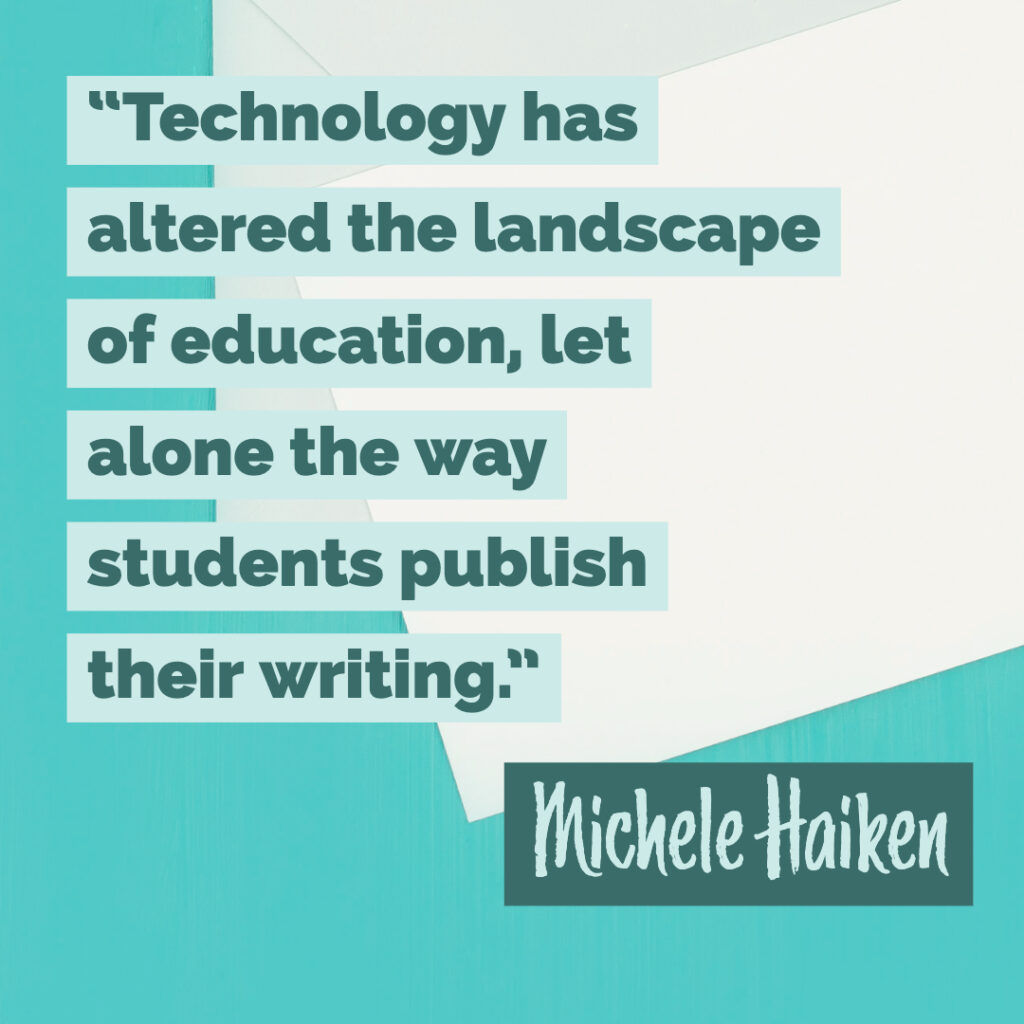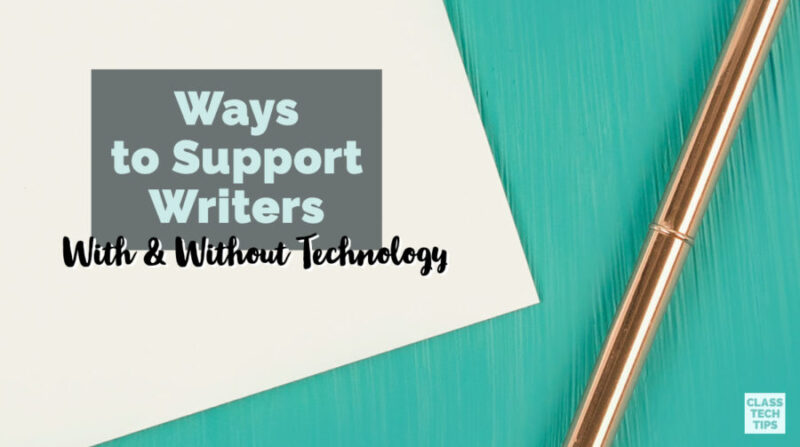There are so many ways to support student writers in your classroom. Whether you’re working with first graders or first-year high school students, there are strategies that support students — both with and without technology.
In this blog post, I’m so excited to share some actionable strategies for classrooms looking to balance digital tools with “analog” experiences. A few years ago, I met Michele Haiken at an EdCamp in New York. We connected earlier this year again at the FETC Conference in Miami, where we both had presentations sharing strategies with teachers.
Supporting Student Writers
Michele has a brand new book that I can’t wait to share with you. It’s called New Realms for Writing: Inspire Student Expression with Digital Age Formats and discusses strategies you can try out right away with students. Michele is a literacy teacher at Rye Middle School in Rye, New York, and an adjunct professor at Manhattanville College. She was kind enough to take time to answer questions about her work and her new book. At the bottom of the post, you’ll find a few of my favorite activities for student writers, too!
What motivated you to write a book on this topic?
After just finishing Personalized Reading: Digital Strategies and Tools to Support All Learners (ISTE, 2018), I felt the need to address writing since reading and writing go hand in hand. As a middle school English teacher, reading and writing are intertwined. I wanted to share ways that writing could go beyond short responses and essays in the classroom to help meet 21st Century Skills while at the same time, bolster student writing. If we want students to be creative communicators, we need to expand the role, format, and audience for writing across the content areas.
How has technology changed the way students publish their writing?
Technology has altered the landscape of education, let alone the way students publish their writing. It allows teachers and students to broaden the audience and share their writing with a wider audience, not just between student and teacher. Technology also allows for diverse formats. Students can publish blogs, ebooks, and infographics, in addition to traditional formats like essays and research papers. Students have to write essays throughout secondary school and college, but for the most part, outside of school, we curate a variety of technology forms for learning and understanding.
You provide lots of student work examples in your book. Can you tell us a bit about how non-traditional products like infographics and podcasts have a place in the classroom?

Think about the ways you interact with information today. I might turn on the news when I wake up and then listen to a podcast on my way to work. Once I am in school, I am on a computer reading diverse texts and interacting between print, digital, and visual texts throughout the day. These texts include literature, nonfiction articles, visual texts like photographs, and infographics.
Our students are similar, and we should be having them reading and writing all these different texts to construct knowledge as well as become empowered learners. In my classroom, I want students to be critical consumers of information in all these different formats as well as creative thinkers in the way they present their learning and understanding. I am all for choices and giving students the ability to choose the best format that fits their message.
In the second chapter of the book, you discuss “multigenre” writing. Can you explain what this term means and what it looks like to include multigenre writing in a classroom?
In English class, writing is too compartmentalized. Teachers teach a unit in poetry, then narrative writing, and argumentative writing. We do not need to be so compartmentalized. When students write multigenre projects, they are choosing different genres to showcase a topic or idea.
For example, when my students are reading and writing about World War 2, we read memoirs, biographies, historical fiction, primary sources, photographs, artwork, and poetry about this time period. Students choose a topic within WW2 to research and investigate more. Some choose victims of the Holocaust, resistors, Japanese Internment, or soldiers and build a collection of five different writings in response to the primary sources they read to showcase their topic. A student might write a poem about being sent off to war, a letter to his family members about the horrors on the battlefield, and include visual drawings of the aftermath of a battle in Europe.
Rather than report what happened, I am asking students to step in the shoes of real people and build out their story to share the forgotten stories of the past. Multigenre writing breaks out of the confines of one genre or style of writing and utilizes many formats to communicate an idea.
In your book, you discuss analog techniques, not just digital. Why is it essential to find a balance between techy and not-so-techy experiences?

I think you said it best when you say “balance.” We need that balance to make sure our students can be successful in school and out. We do not live in a completely digital world, and it would be impractical to be completely digital. I still have my students keep a print reading journal for all the reading they do throughout the school year. Students can choose to write notes, create sketchnotes, and I have some students that type up their notes and paste them into their reading journal.
I love reading through their journals and seeing their thinking on paper. I am lucky to have Chromebooks in my classroom, but that is not the reality for every teacher, classroom, or student across the nation. Yes, there are benefits to both digital and analog, but this is also an issue of digital equity.
Use this link to grab a copy of Michele’s new book, New Realms for Writing: Inspire Student Expression with Digital Age Formats
I love how you include poetry in New Realms for Writing. Is there a favorite tech-friendly poetry activity you like to use with students?
I love starting with found poems or blackout poems. I ask my students to choose a song that represents them and copy the song lyrics onto a Google Document. After reading through the song one or two times, students then have to pair the words down by blacking out words or phrases. You might even give students a set number of words that have to remain in their poems.
It is amazing because two students might have the same song, but when they read through and pair down the words to create a new blackout poem, the words or meanings are different based on what is emphasized or what was left out. If students struggle to find words, this activity provides them with the words; they just have to select what will be highlighted on the page.
What advice would you give a group of educators who want to hold a book club for your book?
Share your ideas and expertise within the book club. Take the ideas that I have shared and adapt and revise them to fit the best interests of your students. My hope is that the ideas I presented in the book are a catalyst for you to inspire your students to be innovative, creative, and collaborative.
How can readers connect with you and learn more about your work?
I write weekly on my blog, and I am always sharing out teaching ideas and reflections. My blog offers resources from my books as well as teaching tools to adapt to your classroom and content. I am happy to connect on Twitter and Instagram. We learn from each other, and that makes us all better educators, which in turn, benefits our students.
Activities for Student Writing
I’ve shared a few resources for student writers in the past to support digital storytelling and publishing in the classroom. Here are a few more blog posts with resources to explore around supporting student writers:
- Publish Spark Page as a PDF for Offline Viewing
- Using Augmented Reality for Writing Prompts
- Digital Storytelling Lesson Ideas with Book Creator
Connect with Michele on Twitter @teachingfactor and Instagram @teaching_factor. You can learn more about her work by visiting her website, or use this link to grab a copy of her new book, New Realms for Writing: Inspire Student Expression with Digital Age Formats. Do you have a favorite activity for student writers? Share in the comments below!







